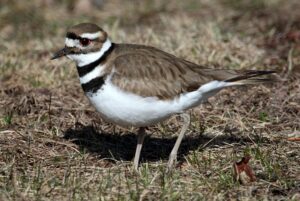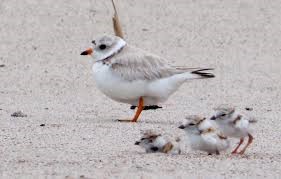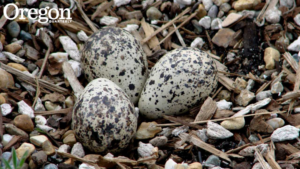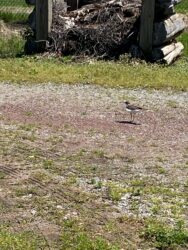By volunteer

Photo credit: Cheryl Conley, TWRC Wildlife Center
As a volunteer naturalist at Bernheim Arboretum and Research Forest, you run into all kinds of neat and interesting discoveries.
You may find a sweet little killdeer like I did, plodding along a gravel road adjacent to some open fields near water. The field will likely be well-groomed, cut short, no taller than an inch – perhaps at a golf-course or open football/soccer field. I have a special place in my heart for all shorebirds, and unlike so many of his shorebird cousins, the killdeer doesn’t mind hanging out on land for a great deal of his life.

Photo by Vince Cavalieri, US Fish & Wildlife Services, courtesy of Gates Dupont, Macaulay Library
I first saw a live killdeer while beekeeping at Bernheim. We were on our way out after checking on some hives and I saw him plodding along quite quickly. He stopped to lock eyes with me and my car’s headlights and I stopped with an excited gasp to witness him. I immediately decided to stop the three other bee keepers following behind my Jeep. I leapt out, initially thinking it to be an odd plover who found his way into Kentucky. A staff member chimed sweetly, “Oh, ha, I know the killdeer are so cute. There were some babies the other day!”
Babies?! Killdeer?! Of course that made much more sense. Killdeer look very similar to their sweet cousins, the piping plover and are actually plovers themselves, part of the numerous species of “plump-breasted” shorebirds.
Killdeer munch mostly on invertebrates like worms, snails, crayfish, grasshoppers, or aquatic insect larvae. They are very clever birds, following farmers as they plow land, awaiting freshly dug up earthworms or insect larvae. They may also hunt frogs or minnows.

Photo by Mary Funk, University of Oregon
When ready to mate and have young little killdeer, they create simple nesting “scrapes” usually in some slight rises in their natural habitat. A scrape is quite literally just that – a scrape in the ground where they nest their eggs. They are deceptive nesters, creating several nesting sites before choosing one to lay in and leaving the rest to confuse predators. They usually sit 3-3.5 inches across and after laying 4-6 eggs, the killdeer may add some trinkets like rocks, shells, twigs, sticks, or sadly, even trash. These materials adorn the nest and keep it safe, protected, and decorative for the young chicks to emerge. They have anywhere from 1-3 broods which incubate for about a month (22-28 days). Like many shorebirds, their eggs are bluff-colored with blackish, moddled spots. They sit about 1.5 inches long in size and have a unique tear drop shape that I love.

By Michael R. Duncan
Something so wonderful about killdeer is that they are shorebirds that come inland, including to your mid-west backyard. Their long, skinny legs, plump and elongated body, scream shorebird right away. The funny little chicks are mirror-miniatures of their adult counterparts. A very cute scene indeed. When they hatch, the chicks are fully functional. They have full, plump feathers and can walk right out of the nest as soon as their feathers dry.

By Hanah Carter
The killdeer is known for its stride – the run and halt – starting and stopping as they search for prey on the ground. Though it often lives in habitats surrounded by human life, it is a very shy little bird. Timid, it runs from you, starting and halting to look back. The one I encountered at Bernheim did this adorably – running gently away and stopping suddenly to look back and determine my threat. Eventually, I went back to my car after snapping a dozen pictures and video and drove towards him. He flew away to nearby refuge away from the car, revealing his bright orange-ish tail feathers. It’s also known to bob up and down like it has the hiccups when looking into the eyes of an intruder.

Courtesy of Wikipedia
The killdeer is also known for its “broken-wing display”. It lures predators away from its nesting eggs by faking injury. Once paired together, two mated killdeer may stay together for 1-3 years or so.
Killdeer population had declined about 47% between 1966-2014 because they choose to nest near people. Killdeer are most susceptible to pesticide poisoning and car accidents. While they are not on a state bird watchlist, killdeer are at as much risk by humans as any other creature – a risk I consider quite high.
Fun killdeer/plover facts:
Collective Noun: Ponderance of plovers; season of Killdeer
Male gives “kill-dee” call during courtship flights!
The killdeer is the largest of ringed plovers.
For more information on Killdeer and their friends, check out these fine websites!
-Hanah Carter, Bernheim Volunteer Naturalist
Click here to read more about the bird research occurring at Bernheim.
For more from Hanah and others, visit sunshoal.blog

